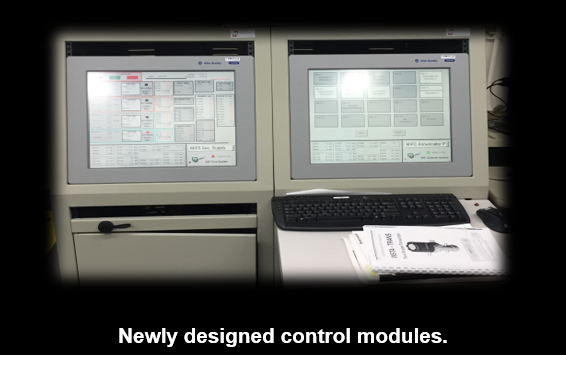
The LDRD Project designed state-of-the-art instrumentation able to monitor and control instrumented materials and fuel experiments during irradiation. The Materials Irradiation Facility (MIF), at the High Flux Isotope Reactor (HFIR) within the Oak Ridge National Laboratory (ORNL), is a key experimental platform that can host fully instrumented experiments in a high neutron flux environment. The facility’s primary functions are to provide inert gas (helium, neon, argon) to the experiments to adjust temperature, monitor irradiation conditions (typically temperatures, gas flowrates and moisture) during irradiation, and monitor effluent gases from experiments for materials and fuel research. Historically, the gas supply and associated control logic were specific to each experiment, requiring a complete redesign; increasing time and experiment cost. The current system has a gas delivery and temperature monitoring system that is both modular and configurable.
Facility Capabilities
The Materials Irradiation Facility offers the in-core measurement capability to support the research for next generation commercial power reactors, accident tolerant fuel and reactor materials, and fusion energy. Experimenters can manage temperature by varying the gas mixture (typically helium, neon, and argon) to influence the effective thermal conductance in one or more zones within the experiment. The MIF can provide in-situ measurements of the key parameters such as thermal conductivity, strain, flux, temperatures, and pressures that are essential for materials and fuel performance research. The new MIF design is now sufficiently flexible to connect a spectrometer to the effluent system to quantitatively measure species of interest in the effluent gas stream. This system will allow real-time measurements of fission gas release and cladding failure in fueled experiments. Previous experimentation has included real time measurements of thermal and electrical conductivities and potential alternative temperature measurement methods that are presently being developed for use in instrumented experiments include the use of ultrasonic thermometry and fiber optic sensors.
Characteristics
All HFIR experiment regions can be instrumented. Two positions located in the flux-trap region are available, the RB* positions have larger irradiation volumes and however have somewhat lower neutron flux levels than the target region. The VXF sites are normally used for isotope production and fuel irradiations because of the low fast-to-thermal flux ratio that is similarity to a light water reactor flux spectrum. The 8 available RB* positions each have a diameter of 1.77 Inches. The 22 Small VXF positions have diameters of 1.75 Inches and the 6 Large VXF positions have diameters of 3 Inches. A variety of experimental specimens are routinely tested including: rods, pellets, coupons, bend bars, tensile, and TEM disks. Experiments can house many sub capsules of different configurations and can be designed for up to 4 temperature zones. If necessary, experiments may also include thermal neutron shielding.
Benefit
The effort re-established a unique HFIR capability allowing instrumented irradiation experiments and made improvements to the MIF that reduce the costs of instrumented irradiation. This project advances ORNL materials capabilities to new levels by providing a state-of-the-art, robust, flexible facility which can be expanded as customer requirements change while supporting the goals of the fusion, advanced fuels, and structural materials programs.
Sponsor
Laboratory Directed Research & Development (LDRD) Programs
Office of Institutional Planning
Oak Ridge National Laboratory



